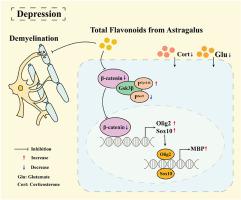当前位置:
X-MOL 学术
›
J. Ethnopharmacol.
›
论文详情
Our official English website, www.x-mol.net, welcomes your
feedback! (Note: you will need to create a separate account there.)
Antidepressant potential of total flavonoids from Astragalus in a chronic stress mouse model: Implications for myelination and Wnt/β-catenin/Olig2/Sox10 signaling axis modulation
Journal of Ethnopharmacology ( IF 4.8 ) Pub Date : 2024-01-30 , DOI: 10.1016/j.jep.2024.117846
Yanlin Tao 1 , Jinfeng Yuan 2 , Houyuan Zhou 1 , Zikang Li 1 , Xiaomeng Yao 1 , Hui Wu 1 , Hailian Shi 1 , Fei Huang 1 , Xiaojun Wu 1
Journal of Ethnopharmacology ( IF 4.8 ) Pub Date : 2024-01-30 , DOI: 10.1016/j.jep.2024.117846
Yanlin Tao 1 , Jinfeng Yuan 2 , Houyuan Zhou 1 , Zikang Li 1 , Xiaomeng Yao 1 , Hui Wu 1 , Hailian Shi 1 , Fei Huang 1 , Xiaojun Wu 1
Affiliation

|
, a versatile traditional Chinese medicinal herb, has a rich history dating back to “Sheng Nong's herbal classic”. It has been employed in clinical practice to address various ailments, including depression. One of its primary active components, total flavonoids from (TFA), remains unexplored in terms of its potential antidepressant properties. This study delves into the antidepressant effects of TFA using a mouse model subjected to chronic unpredictable mild stress (CUMS). The study aimed to scrutinize how TFA influenced depressive behaviors, corticosterone and glutamate levels in the hippocampus, as well as myelin-related protein expression in CUMS mice. Additionally, it sought to explore the involvement of the Wnt/β-catenin/Olig2/Sox10 signaling axis as a potential antidepressant mechanism of TFA. Male C57BL/6 mice were subjected to CUMS to induce depressive behaviors. TFA were orally administered at two different doses (50 mg/kg and 100 mg/kg). A battery of behavioral tests, biochemical analyses, immunohistochemistry, UPLC-MS/MS, real-time PCR, and Western blotting were employed to evaluate the antidepressant potential of TFA. The role of the Wnt/β-catenin/Olig2/Sox10 signaling axis in the antidepressant mechanism of TFA was validated through MO3.13 cells. TFA administration significantly alleviated depressive behaviors in CUMS mice, as evidenced by improved sucrose preference, reduced immobility in tail suspension and forced swimming tests, and increased locomotor activity in the open field test. Moreover, TFA effectively reduced hippocampal corticosterone and glutamate levels and promoted myelin formation in the hippocampus of CUMS mice. Then, TFA increased Olig2 and Sox10 expression while inhibiting the Wnt/β-catenin pathway in the hippocampus of CUMS mice. Finally, we further confirmed the role of TFA in promoting myelin regeneration through the Wnt/β-catenin/Olig2/Sox10 signaling axis in MO3.13 cells. TFA exhibited promising antidepressant effects in the CUMS mouse model, facilitated by the restoration of myelin sheaths and regulation of corticosterone, glutamate, Olig2, Sox10, and the Wnt/β-catenin pathway. This research provides valuable insights into the potential therapeutic application of TFA in treating depression, although further investigations are required to fully elucidate the underlying molecular mechanisms and clinical relevance.
中文翻译:

黄芪总黄酮在慢性应激小鼠模型中的抗抑郁潜力:对髓鞘形成和 Wnt/β-catenin/Olig2/Sox10 信号轴调节的影响
是一种用途广泛的传统中药材,其悠久的历史可以追溯到《神农本草经》。它已在临床实践中用于治疗各种疾病,包括抑郁症。其主要活性成分之一,来自 TFA 的总黄酮,其潜在的抗抑郁特性仍未得到探索。这项研究使用遭受慢性不可预测轻度应激 (CUMS) 的小鼠模型,深入探讨了 TFA 的抗抑郁作用。该研究旨在探讨 TFA 如何影响 CUMS 小鼠的抑郁行为、海马皮质酮和谷氨酸水平以及髓磷脂相关蛋白的表达。此外,它还试图探索 Wnt/β-catenin/Olig2/Sox10 信号轴的参与作为 TFA 的潜在抗抑郁机制。对雄性 C57BL/6 小鼠进行 CUMS 诱导抑郁行为。以两种不同剂量(50 mg/kg 和 100 mg/kg)口服 TFA。采用一系列行为测试、生化分析、免疫组织化学、UPLC-MS/MS、实时 PCR 和蛋白质印迹来评估 TFA 的抗抑郁潜力。 Wnt/β-catenin/Olig2/Sox10信号轴在TFA抗抑郁机制中的作用通过MO3.13细胞得到验证。 TFA 给药显着减轻了 CUMS 小鼠的抑郁行为,这可以通过改善蔗糖偏好、减少悬尾和强迫游泳测试中的不动性以及增加旷场测试中的运动活动来证明。此外,TFA能有效降低CUMS小鼠海马皮质酮和谷氨酸水平,促进海马髓磷脂形成。然后,TFA 增加了 CUMS 小鼠海马中 Olig2 和 Sox10 的表达,同时抑制 Wnt/β-catenin 通路。 最后,我们进一步证实了TFA在MO3.13细胞中通过Wnt/β-catenin/Olig2/Sox10信号轴促进髓磷脂再生的作用。 TFA 在 CUMS 小鼠模型中表现出良好的抗抑郁作用,这得益于髓鞘的恢复以及皮质酮、谷氨酸、Olig2、Sox10 和 Wnt/β-catenin 通路的调节。这项研究为 TFA 在治疗抑郁症方面的潜在治疗应用提供了宝贵的见解,尽管还需要进一步研究以充分阐明潜在的分子机制和临床相关性。
更新日期:2024-01-30
中文翻译:

黄芪总黄酮在慢性应激小鼠模型中的抗抑郁潜力:对髓鞘形成和 Wnt/β-catenin/Olig2/Sox10 信号轴调节的影响
是一种用途广泛的传统中药材,其悠久的历史可以追溯到《神农本草经》。它已在临床实践中用于治疗各种疾病,包括抑郁症。其主要活性成分之一,来自 TFA 的总黄酮,其潜在的抗抑郁特性仍未得到探索。这项研究使用遭受慢性不可预测轻度应激 (CUMS) 的小鼠模型,深入探讨了 TFA 的抗抑郁作用。该研究旨在探讨 TFA 如何影响 CUMS 小鼠的抑郁行为、海马皮质酮和谷氨酸水平以及髓磷脂相关蛋白的表达。此外,它还试图探索 Wnt/β-catenin/Olig2/Sox10 信号轴的参与作为 TFA 的潜在抗抑郁机制。对雄性 C57BL/6 小鼠进行 CUMS 诱导抑郁行为。以两种不同剂量(50 mg/kg 和 100 mg/kg)口服 TFA。采用一系列行为测试、生化分析、免疫组织化学、UPLC-MS/MS、实时 PCR 和蛋白质印迹来评估 TFA 的抗抑郁潜力。 Wnt/β-catenin/Olig2/Sox10信号轴在TFA抗抑郁机制中的作用通过MO3.13细胞得到验证。 TFA 给药显着减轻了 CUMS 小鼠的抑郁行为,这可以通过改善蔗糖偏好、减少悬尾和强迫游泳测试中的不动性以及增加旷场测试中的运动活动来证明。此外,TFA能有效降低CUMS小鼠海马皮质酮和谷氨酸水平,促进海马髓磷脂形成。然后,TFA 增加了 CUMS 小鼠海马中 Olig2 和 Sox10 的表达,同时抑制 Wnt/β-catenin 通路。 最后,我们进一步证实了TFA在MO3.13细胞中通过Wnt/β-catenin/Olig2/Sox10信号轴促进髓磷脂再生的作用。 TFA 在 CUMS 小鼠模型中表现出良好的抗抑郁作用,这得益于髓鞘的恢复以及皮质酮、谷氨酸、Olig2、Sox10 和 Wnt/β-catenin 通路的调节。这项研究为 TFA 在治疗抑郁症方面的潜在治疗应用提供了宝贵的见解,尽管还需要进一步研究以充分阐明潜在的分子机制和临床相关性。

































 京公网安备 11010802027423号
京公网安备 11010802027423号